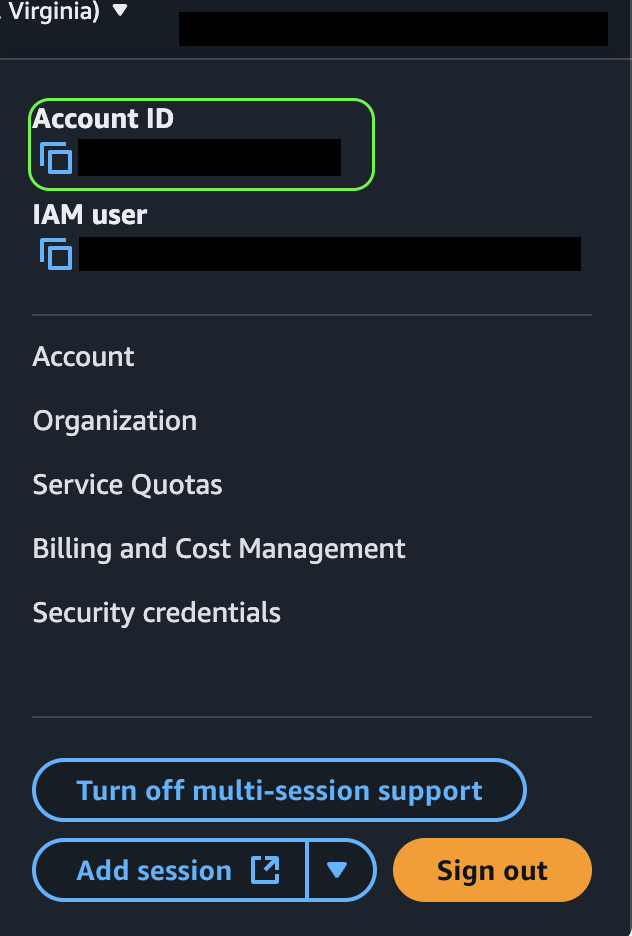AWS Identity and Access Management (IAM) - Pod-based identity | Entitle
How does it work?
Entitle integrates with AWS by assuming a role that you configure. This role enables Entitle to manage access dynamically based on approved requests.
- For on-premises deployments, the role is assumed by the agent pod's IAM role.
- When a request for access to an EC2 instance, S3 bucket, or IAM role is approved, Entitle automatically creates a policy with the required permissions and attaches it to the corresponding IAM user.
- For requests targeting an IAM policy or IAM group, Entitle grants access directly without creating a new policy.
Prerequisites
To integrate AWS with Entitle, the following setup is required:
- Create an IAM Role with a trust relationship that allows Entitle to assume it.
- Assign the necessary permissions to the role using inline policies.
Set up AWS to work with Entitle
Obtain your account ID
Click the top-right corner of your screen and copy it the value under Account ID. Save it for later on in the configuration.

Set up an AWS access role
- Create an IAM Role in the desired account. Save that role's ARN aside; it will be used to configure your AWS integration later on.
- To establish a secure connection between Entitle and your AWS account, you must define a trust relationship that allows Entitle to assume the role you created. Add the following trust relationship policy to the role:
{
"Version": "2012-10-17",
"Statement": [
{
"Effect": "Allow",
"Principal": {
"AWS": "arn:aws:iam::321183744702:role/entitle-prod-ichilov@entitle"
},
"Action": "sts:AssumeRole",
"Condition": {
"StringEquals": {
"sts:ExternalId": "<EXTERNAL_ID>"
}
}
}
]
}
{
"Version": "2012-10-17",
"Statement": [
{
"Effect": "Allow",
"Principal": {
"AWS": "arn:aws:iam::396913696231:role/entitle-prod-us-ichilov@entitle"
},
"Action": "sts:AssumeRole",
"Condition": {
"StringEquals": {
"sts:ExternalId": "<EXTERNAL_ID>"
}
}
}
]
}
{
"Version": "2012-10-17",
"Statement": [
{
"Effect": "Allow",
"Principal": {
"AWS": "<Your agent-pod's AWS role ARN>"
},
"Action": "sts:AssumeRole",
"Condition": {
"StringEquals": {
"sts:ExternalId": "<EXTERNAL_ID>"
}
}
}
]
}
- Entitle uses AWS's external ID feature. Create a value for External ID, set it under
"sts:ExternalId"and save the value; you will need it later in this guide. - Add an inline policy to the user you’ve just created

{
"Version": "2012-10-17",
"Statement": [
{
"Sid": "MergedPolicy0",
"Effect": "Allow",
"Action": [
"iam:AttachRolePolicy",
"iam:PutRolePolicy",
"iam:AttachUserPolicy",
"iam:CreateRole",
"iam:CreatePolicy",
"iam:CreatePolicyVersion",
"iam:DetachUserPolicy",
"iam:DetachRolePolicy",
"iam:DeleteRole",
"iam:DeletePolicy",
"iam:DeletePolicyVersion",
"iam:GetPolicy",
"iam:GetPolicyVersion",
"iam:GetRole",
"iam:ListRoles",
"iam:ListAttachedRolePolicies",
"iam:ListEntitiesForPolicy",
"iam:ListPolicies",
"iam:ListPolicyTags",
"iam:ListPolicyVersions",
"iam:ListRolePolicies",
"iam:ListRoleTags",
"iam:ListUserPolicies",
"iam:ListUsers",
"iam:TagPolicy",
"iam:UntagPolicy",
"iam:TagRole",
"iam:UnTagRole",
"organizations:ListAccounts",
"organizations:DescribeAccount",
"iam:AddUserToGroup",
"iam:RemoveUserFromGroup",
"iam:ListGroupsForUser",
"iam:ListGroups",
"iam:GetUser",
"iam:GetGroup"
],
"Resource": "*"
}
]
}
- For each resource type you wish to manage, attach another inline policy:
{
"Version": "2012-10-17",
"Statement": [
{
"Sid": "VisualEditor0",
"Effect": "Allow",
"Action": [
"iam:ListPolicies",
"iam:GetPolicyVersion",
"iam:GetPolicy",
"iam:TagRole",
"iam:ListEntitiesForPolicy",
"iam:AttachUserPolicy",
"iam:ListUsers",
"iam:ListUserPolicies",
"iam:ListPolicyTags",
"iam:TagPolicy",
"iam:TagUser"
],
"Resource": "*"
}
]
}
{
"Version": "2012-10-17",
"Statement": [
{
"Sid": "VisualEditor0",
"Effect": "Allow",
"Action": [
"iam:ListPolicies",
"iam:GetRole",
"iam:GetPolicyVersion",
"s3:GetBucketTagging",
"ec2:DescribeInstances",
"iam:GetPolicy",
"ec2:DescribeTags",
"ec2:DescribeRegions",
"iam:ListEntitiesForPolicy",
"iam:AttachUserPolicy",
"s3:ListBucket",
"iam:ListUserPolicies",
"iam:CreatePolicy",
"s3:ListAllMyBuckets",
"iam:ListUsers",
"iam:ListPolicyTags",
"iam:DetachUserPolicy"
],
"Resource": "*"
}
]
}
{
"Version": "2012-10-17",
"Statement": [
{
"Sid": "VisualEditor0",
"Effect": "Allow",
"Action": [
"iam:ListPolicies",
"iam:GetRole",
"iam:GetPolicyVersion",
"iam:ListRoleTags",
"iam:GetPolicy",
"iam:AttachUserPolicy",
"iam:ListEntitiesForPolicy",
"iam:ListRoles",
"iam:ListUserPolicies",
"iam:CreatePolicy",
"iam:ListUsers",
"iam:ListPolicyTags",
"iam:DetachUserPolicy"
],
"Resource": "*"
}
]
}
- Copy the role’s ARN, you’ll use it later in this guide.

Set up the integration in Entitle
-
Log in to Entitle and go to the Integrations page.
-
Click Add Integration and type AWS in the Application field.
-
Don’t forget to set the Save on field with your configuration, i.e., your own hosted agent or Entitle’s cloud.
-
In the Connection section, select IAM Single Account.
-
Fill in the required components in the configuration:
- Paste the account ID of the account you wish to manage resources on as the
account_idvalue. - Paste the ARN of the Entitle role as the
access_role_arn value. - Paste your external ID as the
external_idvalue. - Paste your region code as the
regionvalue. - Under the
optionsconfiguration, add the tags'keyandvaluein case you wish to retrieve only resources with the listed tags.
- Paste the account ID of the account you wish to manage resources on as the
{
"root_account": {
"account_id": "", // Your root account ID
"access_role_arn": "", // Your access role ARN previously copied
"external_id": "", // External ID set in the access role's trust-relationship
"region": "" // Your region
},
"options": {
"tags": [
{
"key": "", // Tag key of resources to be fetched
"value": "" // Tag value of resources to be fetched
}
]
}
}
}
- Click Save.
Updated 2 days ago
